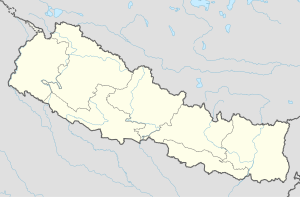갑옷쥐
Armored rat| 갑옷쥐 | |
|---|---|
 | |
| 과학적 분류 | |
| 왕국: | 애니멀리아 |
| 문: | 챠다타 |
| 클래스: | 젖꼭지 |
| 주문: | 설치류 |
| 패밀리: | 에키미과 |
| 서브패밀리: | 에키미아과 |
| 부족: | 미오카스토리니 |
| 속: | 호플로미스속 1908년 J. A. 알렌 |
| 종류: | 나체 |
| 이항명 | |
| 털북숭이 (Thomas, 1897년) | |
 | |
| 갑옷쥐의 분포 | |
갑옷쥐(Hoplomys gymurus)는 비단털쥐과에 속하는 설치류의 일종이다.호플로미스속에서는 [2]단형이다.그것은 온두라스 북부에서 에콰도르 북서부까지 라틴 아메리카에서 발견됩니다.등과 몸의 [3]측면에 다양한 가시가 있습니다.
묘사
성인의 몸무게는 218~790그램(0.481~1.742파운드)이며, 수컷은 암컷보다 평균 무게가 더 나간다.그들은 부드러운 털을 가지고 태어나고, 첫 달 후에 가시가 자라기 시작합니다.등과 측면에 있는 두꺼운 가시들은 최대 33밀리미터(1.3인치)와 2밀리미터(0.079인치) [4]직경이 됩니다.머리와 몸의 길이는 220~320mm(8.7~12.6인치)이며 꼬리는 150~255mm(5.9~10.0인치)[4]를 더한다.갑옷쥐의 색깔은 검은색에서 적갈색까지 다양하며, 하체는 순백색이다.겉모습은 토메가시쥐와 비슷하지만, 갑옷쥐의 눈은 더 작고 [3]코는 더 길다.먹이는 과일, 곤충, 녹색 식물이다.보통 쓰레기의 크기는 1에서 [3]3까지입니다.
서식지
갑옷쥐는 야행성 동물로 굴을 차지하고 있다.이러한 굴은 보통 수원에 가까운 가파른 둑에 위치하고 둥지방에 [3]도달하기 전에 최대 2m(6.6피트)의 길이를 측정할 수 있습니다.그들은 온두라스 북부에서 에콰도르 북서부, 파나마나의 고립된 카리브해의 섬인 Isla Escudo de Veraguas를 [5]포함한 해발 [3]약 800m(2,600ft)의 저지대에서부터 분포한다.
어원학
- 호플로미스속은 "갑옷"을 뜻하는 고대 그리스어 λννννν (호플론)과 "쥐"[6][7]를 뜻하는 μῦ (m (m),s)에서 유래했다.
- '나체'라는 이름은 '벌거벗은'이라는 뜻의 고대 그리스어 νμν (gggggg(gumnos)와 '꼬리'를 뜻하는 ὐμ ( (ourourourourourourourourourour the(오우라)에서 유래했다.
계통발생학
갑옷쥐는 갈색 쥐보다 고슴도치, 기니피그, 친칠라,[8][9] 일반 데구스와 더 가깝다.
Echimyidae에 속하는 Hoplomys속은 Proechimys속의 자매군이다.차례로, 이 두 분류군은 다른 미오카스토리니속과 진화적 친화력을 공유한다: 한편으로는 칼리스토미스속과 미오카스토르속 그리고 다른 한편으로는 트리코미스속이다.
| 미오카스토리니의 속 레벨 분해도. | ||||||||||||||||||||||||
| ||||||||||||||||||||||||
| 분지도는 미토콘드리아와 핵 DNA [10][11][12][13][14][15][16]특성으로부터 재구성되었다. |
레퍼런스
- 특정한
- ^ Anderson, R.P.; Emmons, L. (2016). "Hoplomys gymnurus". IUCN Red List of Threatened Species. 2016: e.T10259A22206995. doi:10.2305/IUCN.UK.2016-2.RLTS.T10259A22206995.en. Retrieved 12 November 2021.
- ^ Woods, C.A.; Kilpatrick, C.W. (2005). "Infraorder Hystricognathi". In Wilson, D.E.; Reeder, D.M (eds.). Mammal Species of the World: A Taxonomic and Geographic Reference (3rd ed.). Johns Hopkins University Press. p. 1583. ISBN 978-0-8018-8221-0. OCLC 62265494.
- ^ a b c d e Reid, Fiona (1997). A Field Guide to the Mammals of Central America & Southeast Mexico. New York: Oxford University Press. pp. 251–252. ISBN 9780195343229.
- ^ a b Nowak, Ronald M (1999). Walker's Mammals of the World. Baltimore: Johns Hopkins University Press. p. 1689. ISBN 978-0-8018-5789-8.
- ^ Handley, C.O. (1959). "A review of the genus Hoplomys (thick-spined rats), with description of a new form from Isla Escudo de Veraguas, Panama". Smithsonian Miscellaneous Collections. Smithsonian Institution. 139 (4): 1–10. hdl:10088/22959. OCLC 906190284.
- ^ Bailly, Anatole (1981-01-01). Abrégé du dictionnaire grec français. Paris: Hachette. ISBN 978-2010035289. OCLC 461974285.
- ^ Bailly, Anatole. "Greek-french dictionary online". www.tabularium.be. Retrieved 2017-01-24.
- ^ Huchon, Dorothée; Douzery, Emmanuel J.P. (2001). "From the Old World to the New World: A Molecular Chronicle of the Phylogeny and Biogeography of Hystricognath Rodents". Molecular Phylogenetics and Evolution. 20 (2): 238–251. doi:10.1006/mpev.2001.0961. PMID 11476632.
- ^ Reid, Fiona (2010). The Wildlife of Costa Rica. Ithaca, N.Y.: Comstock Pub. Associates. p. 17. ISBN 978-0-8014-7610-5.
- ^ Galewski, Thomas; Mauffrey, Jean-François; Leite, Yuri L. R.; Patton, James L.; Douzery, Emmanuel J. P. (2005). "Ecomorphological diversification among South American spiny rats (Rodentia; Echimyidae): a phylogenetic and chronological approach". Molecular Phylogenetics and Evolution. 34 (3): 601–615. doi:10.1016/j.ympev.2004.11.015. PMID 15683932.
- ^ Upham, Nathan S.; Patterson, Bruce D. (2012). "Diversification and biogeography of the Neotropical caviomorph lineage Octodontoidea (Rodentia: Hystricognathi)". Molecular Phylogenetics and Evolution. 63 (2): 417–429. doi:10.1016/j.ympev.2012.01.020. PMID 22327013.
- ^ Fabre, Pierre-Henri; Galewski, Thomas; Tilak, Marie-ka; Douzery, Emmanuel J. P. (2013-03-01). "Diversification of South American spiny rats (Echimyidae): a multigene phylogenetic approach". Zoologica Scripta. 42 (2): 117–134. doi:10.1111/j.1463-6409.2012.00572.x. ISSN 1463-6409. S2CID 83639441.
- ^ Loss, Ana; Moura, Raquel T.; Leite, Yuri L. R. (2014). "Unexpected phylogenetic relationships of the painted tree rat Callistomys pictus (Rodentia: Echimyidae)" (PDF). Natureza on Line. 12: 132–136.
- ^ Fabre, Pierre-Henri; Vilstrup, Julia T.; Raghavan, Maanasa; Der Sarkissian, Clio; Willerslev, Eske; Douzery, Emmanuel J. P.; Orlando, Ludovic (2014-07-01). "Rodents of the Caribbean: origin and diversification of hutias unravelled by next-generation museomics". Biology Letters. 10 (7): 20140266. doi:10.1098/rsbl.2014.0266. ISSN 1744-9561. PMC 4126619. PMID 25115033.
- ^ Upham, Nathan S.; Patterson, Bruce D. (2015). "Evolution of Caviomorph rodents: a complete phylogeny and timetree for living genera". In Vassallo, Aldo Ivan; Antenucci, Daniel (eds.). Biology of caviomorph rodents: diversity and evolution. Buenos Aires: SAREM Series A, Mammalogical Research — Sociedad Argentina para el Estudio de los Mamíferos. pp. 63–120.
- ^ Fabre, Pierre-Henri; Upham, Nathan S.; Emmons, Louise H.; Justy, Fabienne; Leite, Yuri L. R.; Loss, Ana Carolina; Orlando, Ludovic; Tilak, Marie-Ka; Patterson, Bruce D.; Douzery, Emmanuel J. P. (2017-03-01). "Mitogenomic Phylogeny, Diversification, and Biogeography of South American Spiny Rats". Molecular Biology and Evolution. 34 (3): 613–633. doi:10.1093/molbev/msw261. ISSN 0737-4038. PMID 28025278.
- 일반
- 우즈, C.A., C.W. 킬패트릭2005. Hystricognathi. pp 1538–1600, 세계 포유류의 종. 분류학 및 지리학 참조서 제3판.D.E. Wilson과 D.리더 에드 씨스미스소니언 인스티튜트 프레스, 워싱턴 D.C.



